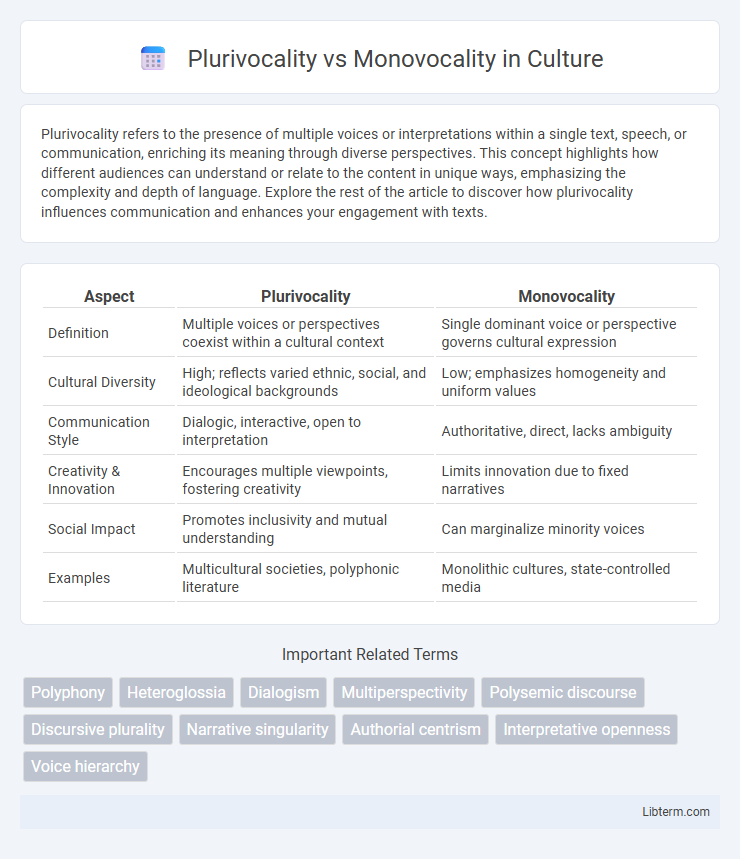Plurivocality refers to the presence of multiple voices or interpretations within a single text, speech, or communication, enriching its meaning through diverse perspectives. This concept highlights how different audiences can understand or relate to the content in unique ways, emphasizing the complexity and depth of language. Explore the rest of the article to discover how plurivocality influences communication and enhances your engagement with texts.
Table of Comparison
| Aspect | Plurivocality | Monovocality |
|---|---|---|
| Definition | Multiple voices or perspectives coexist within a cultural context | Single dominant voice or perspective governs cultural expression |
| Cultural Diversity | High; reflects varied ethnic, social, and ideological backgrounds | Low; emphasizes homogeneity and uniform values |
| Communication Style | Dialogic, interactive, open to interpretation | Authoritative, direct, lacks ambiguity |
| Creativity & Innovation | Encourages multiple viewpoints, fostering creativity | Limits innovation due to fixed narratives |
| Social Impact | Promotes inclusivity and mutual understanding | Can marginalize minority voices |
| Examples | Multicultural societies, polyphonic literature | Monolithic cultures, state-controlled media |
Defining Plurivocality and Monovocality
Plurivocality refers to the presence of multiple voices or perspectives within a text, allowing diverse interpretations and meanings to coexist. Monovocality signifies a single, dominant voice or interpretation that guides the understanding of a text, limiting alternative viewpoints. These concepts are crucial in literary theory, communication studies, and discourse analysis to examine how meaning is constructed and contested.
Historical Origins of Plurivocal and Monovocal Approaches
Plurivocality and monovocality trace their historical origins to distinct cultural and philosophical traditions shaping communication and interpretation. Plurivocal approaches emerged from polysemous contexts such as postmodern thought and multicultural societies, emphasizing multiple meanings and interpretive pluralism. In contrast, monovocality has roots in classical and Enlightenment paradigms favoring singular, authoritative meaning for clarity and uniform understanding.
Key Characteristics of Plurivocal Discourse
Plurivocal discourse features multiple voices and perspectives that coexist within a text or conversation, creating a dynamic interplay of meanings and interpretations. This type of discourse is characterized by dialogism, heteroglossia, and the presence of diverse narrative viewpoints that resist a single, authoritative voice. It enhances complexity and richness in communication by allowing polyphony and acknowledging the multiplicity of social and cultural contexts.
Features of Monovocal Narratives
Monovocal narratives are characterized by a single, unified voice that shapes the story's perspective and interpretation without incorporating multiple viewpoints. These narratives emphasize coherence and consistency, often reflecting a dominant ideology or author's intent, which streamlines the audience's understanding. The focus on one narrative voice limits ambiguity, promoting a clear, authoritative account of events or ideas.
Plurivocality in Literary and Academic Contexts
Plurivocality in literary and academic contexts enriches texts by incorporating multiple voices, perspectives, and interpretations, fostering a dynamic interplay of meanings that challenge singular narratives. This multiplicity enhances critical analysis and promotes diverse, often conflicting viewpoints, which are essential for advancing scholarly discourse and deepening literary complexity. Engaging with plurivocal texts facilitates a broader understanding of cultural, social, and ideological frameworks, making it a crucial concept for contemporary studies in literature and humanities.
The Role of Monovocality in Traditional Media
Monovocality in traditional media emphasizes a single, authoritative voice that shapes public discourse and maintains control over information dissemination. This approach often limits diverse perspectives, reinforcing dominant narratives and influencing audience perception through uniform messaging. The centralization of monovocality ensures clear, consistent communication but can hinder pluralism and the representation of marginalized voices.
Advantages of Embracing Plurivocality
Embracing plurivocality fosters diverse perspectives, enhancing creativity and innovation by integrating multiple voices within a discourse. This approach promotes inclusivity and richer understanding by valuing a variety of cultural, social, and intellectual narratives. Organizations and communities adopting plurivocality benefit from increased adaptability and more comprehensive decision-making processes.
Challenges Associated with Monovocality
Monovocality, characterized by a single dominant voice or perspective, poses challenges such as limited diversity of ideas and reduced innovation potential in organizational decision-making. This homogeneity can lead to groupthink, impairing critical analysis and problem-solving capabilities. In contrast, plurivocality encourages multiple viewpoints, fostering creativity and resilience but requiring more complex communication and conflict management strategies.
Real-World Examples: Plurivocality vs Monovocality
Plurivocality, exemplified by multicultural organizations like the United Nations, embraces multiple perspectives to foster inclusive decision-making and richer dialogue. In contrast, monovocality, common in traditional corporate hierarchies such as Apple Inc., emphasizes a single authoritative voice to maintain consistency and operational efficiency. These real-world examples illustrate how plurivocality enhances adaptability in complex environments, while monovocality often drives streamlined execution in goal-oriented settings.
Choosing Between Plurivocal and Monovocal Strategies
Choosing between plurivocal and monovocal strategies requires analyzing the communication goals and audience diversity to ensure message effectiveness. Plurivocal approaches incorporate multiple voices and perspectives, enhancing inclusivity and fostering richer dialogue, ideal for collaborative and diverse environments. Monovocal strategies emphasize a single, unified voice to create clarity and consistency, particularly effective in branding and authoritative communications.
Plurivocality Infographic

 libterm.com
libterm.com